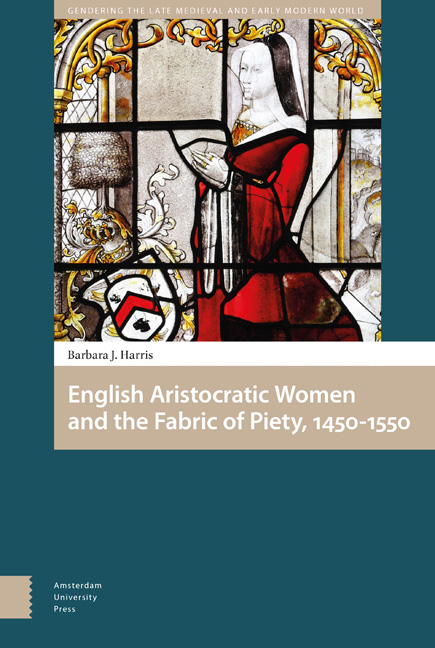Book contents
- Frontmatter
- Dedication
- Contents
- Abbreviations
- Illustrations
- Acknowledgements
- Preface
- Introduction
- 1 Tombs: Honoring the Dead
- 2 Chantries: The Quest for Perpetual Prayers
- 3 Building for the Congregation: Roofs, Aisles, and Stained Glass
- 4 Adorning the Liturgy: Luxury Fabrics and Chapel Plate
- 5 Almshouses and Schools: Prayers and Service to the Community
- 6 Defining Themselves
- 7 Epilogue: Destruction and Survival
- Conclusion
- Appendix 1 Patrons of the Fabric of the Church
- Appendix 2 Patrons of Tombs
- Appendix 3 Location of Tombs in Churches
- Appendix 4 Choice of Burial Companion
- Appendix 5 Women Who Commissioned Chantries
- Appendix 6 Commissions of Stained-Glass Windows
- Appendix 7 Additions or Major Repairs to Churches
- Appendix 8 Bequests of Vestments
- Appendix 9 Patrons of Almshouses or Schools
- Glossary
- Select Bibliography
- Archival Sources
- Index
3 - Building for the Congregation: Roofs, Aisles, and Stained Glass
Published online by Cambridge University Press: 11 December 2020
- Frontmatter
- Dedication
- Contents
- Abbreviations
- Illustrations
- Acknowledgements
- Preface
- Introduction
- 1 Tombs: Honoring the Dead
- 2 Chantries: The Quest for Perpetual Prayers
- 3 Building for the Congregation: Roofs, Aisles, and Stained Glass
- 4 Adorning the Liturgy: Luxury Fabrics and Chapel Plate
- 5 Almshouses and Schools: Prayers and Service to the Community
- 6 Defining Themselves
- 7 Epilogue: Destruction and Survival
- Conclusion
- Appendix 1 Patrons of the Fabric of the Church
- Appendix 2 Patrons of Tombs
- Appendix 3 Location of Tombs in Churches
- Appendix 4 Choice of Burial Companion
- Appendix 5 Women Who Commissioned Chantries
- Appendix 6 Commissions of Stained-Glass Windows
- Appendix 7 Additions or Major Repairs to Churches
- Appendix 8 Bequests of Vestments
- Appendix 9 Patrons of Almshouses or Schools
- Glossary
- Select Bibliography
- Archival Sources
- Index
Summary
Aristocratic women commissioned chapels and tombs in their parish churches to secure prayers for their souls and to create permanent memorials of their wealth and status. But they were also cognizant of their responsibilities to the communities they and their families dominated. In addition to projects for their personal benefit, they therefore funded repairs and additions to the naves, aisles, roofs, and chancels of their parish churches, projects that benefited their villages as a whole. The women's marriages, single or multiple, their residences, their birthplaces, and their connections to manors they inherited or held as part of their jointures all influenced their legacies to their churches. The specificity of their gifts indicates that they thought about them carefully and had considerable knowledge of the institutions they were benefitting. Their bequests also demonstrate the breadth of their landownership: many of them had ties to more than one parish and many of them to more than one county. As a result, they often extended this kind of patronage to churches outside the parish in which their chief residences were located.
Many of the women's gifts were relatively small legacies for repairs to the church in which they were to be buried. These bequests were in addition to those that testators routinely gave to their parishes for forgotten tithes and for candles and torches for their funerals. Thus, Isabella Sapcote (1494) left 20 marks for “edifying and building” the church in Burley, Rutland, and Elizabeth Fineux (1539) bequeathed £5 or £6 to her church at Herne, Kent. Both women planned to be buried in the churches and had lived in the parish, although neither of their deceased husbands was interred there. Widows made different choices when they married more than once. Margaret, Countess of Kent (1541), planned to be buried with the earl, her third spouse, at White Friars, London, but left ten shillings for repairs at St Anne's within Aldwych Gate, London, the burial place of her first husband. Dorothy Hungerford (1559) donated 40 shillings to repair the church of East Shefford, Berkshire, where she hoped to lie with her first husband, John Fettiplace (1524), although she was living in Down Ampney, Gloucestershire, which had belonged to her deceased second husband, Sir Anthony Hungerford (1558).
- Type
- Chapter
- Information
- Publisher: Amsterdam University PressPrint publication year: 2018



